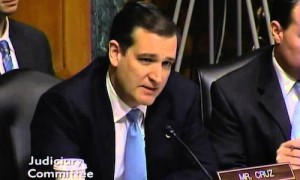|

Let me elaborate.
1. Cruz is positioned as the most conservative candidate in the race. Although Trump gets all the attention for his over-the-top statements, Cruz has staked out a position on the far right on virtually every major hot-button issue, including immigration, Obamacare, national security and the fight against the Islamic State militant group. And, tonally, Cruz comes across as aggressively and unapologetically conservative — a less controversial and more electable version of real estate magnate Trump.
A Washington Post-ABC News November poll showed that Cruz’s numbers are in the stratosphere among voters who identify themselves as “very” conservative; 69 percent had a favorable opinion of him while just 21 percent regarded him in an unfavorable light.
In a Republican primary — particularly one in which the GOP electorate is mad at everyone (including those in their own party) for an alleged lack of commitment to conservative principles — being the guy all the way on the ideological right is a very, very good thing.
2. Cruz has raised the second-most money in the Republican race. Bet you didn’t know that! Yes, former Florida governor Jeb Bush is by far and away the fundraising leader in the race. Not only did we know that would be the case, but we also now know that it has done him, roughly, zero good. Cruz’s money, on the other hand, is — or at least was — unexpected.
Cruz’s $65 million raised is all the more impressive because, unlike Bush, who raised the vast majority of his money with the support of his Right to Rise super PAC, Cruz has a relatively even balance between the funds raised for his campaign committee ($26.5 million) and those collected by a universe of supportive super PACs ($38 million). Having so much money in his campaign account means that Cruz will get more bang for his buck, because candidates get the lowest unit rate on TV ad buying while super PACs have to pay full freight for their airtime.
Cruz’s money is also what separates him from other candidates who secured the mantle of “most conservative candidate in the primary.” Former Arkansas governor Mike Huckabee and former senator from Pennsylvania Rick Santorum won the Iowa caucuses during past campaigns — more on Cruz and Iowa below — but they were unable to capitalize on that win or sustain their support because they had so little money.
Cruz is the best-case scenario for those who want to see a movement conservative nominated: He’s of the conservative movement but has the fundraising ability of an establishment Republican.
3. Cruz is the Iowa front-runner. Recent history makes clear that you need to win one of the first three states — Iowa, New Hampshire or South Carolina — to have a realistic chance of being the party’s nominee. (Remember how well former New York City mayor Rudy Giuliani’s “wait until Florida” strategy worked in 2008? Thought so.)
Cruz is emerging rapidly as the favorite in Iowa’s caucuses. Three polls released in the past five days put Cruz at the front of the pack in Iowa — including the influential (and almost always right) Des Moines Register survey, which had the senator from Texas 10 points clear of Trump.
Winning Iowa would give Cruz momentum going into New Hampshire — where he currently sits at third — and into South Carolina, a state, like Iowa, whose Republican primary electorate is quite socially conservative.
4. The calendar beyond the Big 3 favors Cruz. Winning one of the first three states is almost certainly the way a candidate makes it to March. But assuming Cruz can win Iowa (at least), the calendar starts to look very favorable to him beyond February. On March 1, what’s being referred to as the “SEC primary” takes place; Alabama, Arkansas, Georgia, Tennessee and Texas will vote on that first Tuesday in March.
It’s difficult to handicap how those states might play out because of how much the first three states in the past have influenced who stays in the race and what their poll numbers look like. Still, Cruz’s profile as the one true constitutional conservative in the race, coupled with his Southern roots and his fundraising, should make for an attractive package for voters going to the polls that day.
The next big primary day is two weeks later, on March 15, when Florida, Illinois, Missouri, North Carolina and Ohio vote. There are less obvious wins in those states for Cruz, but he would almost certainly run well in North Carolina and Missouri under any circumstance and might do well in the other three states depending on who else was left in the contest.
Yes, Cruz has weaknesses — most notably that he has shown little ability to appeal beyond his conservative base and that he is far less likable than, say, Rubio, if it comes down to a one-on-one fight between the two. Rubio of Florida is also trying to make an issue of Cruz’s immigration stance — insisting that Cruz has less of a hard line on the issue than he lets on.
But Trump (being Trump) and Rubio (what early state does he win?) also have problems. And Cruz’s strengths are considerable, particularly when you consider how these races typically play out.
Cruz has begun his ascent up the early state and national polls at just about the right time. (The race will go into deep freeze from around next week through the beginning of 2016.) His campaign is perfectly positioned to make him the last man standing. Believe it.
Chris Cillizza writes “The Fix,” a politics blog for the Washington Post. He also covers the White House.









